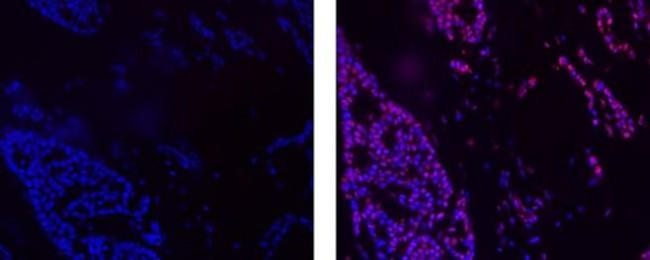Search Thermo Fisher Scientific
Invitrogen
Cyclin E Monoclonal Antibody (HE12), eFluor™ 660, eBioscience™
FIGURE: 1 / 1
Cyclin E Antibody (50-9714-80) in IHC (P)

Product Details
50-9714-80
Species Reactivity
Host/Isotype
Recommended Isotype Control
Class
Type
Clone
Conjugate
Excitation/Emission Max
Form
Concentration
Purification
Storage buffer
Contains
Storage conditions
Shipping conditions
RRID
Product Specific Information
Description: The monoclonal antibody HE12 recognizes human Cyclin E. Cyclins regulate the cell cycle by binding and activating cyclin-dependent kinases (CDK). Cyclin E regulates the transition from G1 to S phase by binding and activating CDK2. The Cyclin E/CDK2 complex is responsible for the phosphorylation of downstream proteins that facilitate the G1 to S phase transition. Overexpression of Cyclin E is found in several types of cancer including breast, colon, bladder, lung and skin. In breast cancer, Cyclin E overexpression is associated with increased stage and grade as well as poor prognosis.
Applications Reported: This HE12 antibody has been reported for use in immunohistochemical staining of formalin-fixed paraffin embedded tissue sections and microscopy.
Applications Tested: This HE12 antibody has been tested by immunohistochemistry of FFPE human tissue using low pH antigen retreival and can be used at less than or equal to 10 µg/mL. It is recommended that the antibody be carefully titrated for optimal performance in the assay of interest.
eFluor® 660 is a replacement for Alexa Fluor® 647. eFluor® 660 emits at 659 nm and is excited with the red laser (633 nm). Please make sure that your instrument is capable of detecting this fluorochome.
Excitation: 633-647 nm; Emission: 668 nm; Laser: Red Laser.
Filtration: 0.2 µm post-manufacturing filtered.
Target Information
Cyclin E belongs to the highly conserved cyclin family, whose members are characterized by a dramatic periodicity in protein abundance through the cell cycle. Cyclins function as regulators of CDK kinases. Different cyclins exhibit distinct expression and degradation patterns which contribute to the temporal coordination of each mitotic event. Cyclin E forms a complex with and functions as a regulatory subunit of CDK2, whose activity is required for cell cycle G1/S transition. This protein accumulates at the G1-S phase boundary and is degraded as cells progress through S phase. Overexpression of this gene has been observed in many tumors, which results in chromosome instability, and thus may contribute to tumorigenesis. This protein was found to associate with, and be involved in, the phosphorylation of NPAT protein (nuclear protein mapped to the ATM locus), which participates in cell-cycle regulated histone gene expression and plays a critical role in promoting cell-cycle progression in the absence of pRB. Two alternatively spliced transcript variants of this gene, which encode distinct isoforms, have been described. Two additional splice variants were reported but detailed nucleotide sequence information is not yet available.
For Research Use Only. Not for use in diagnostic procedures. Not for resale without express authorization.
References (0)
Bioinformatics
Protein Aliases: cyclin Es; cyclin Et; E-S; G1/S-specific cyclin-E1
Gene Aliases: CCNE; CCNE1; pCCNE1
UniProt ID: (Human) P24864
Entrez Gene ID: (Human) 898

Performance Guarantee
If an Invitrogen™ antibody doesn't perform as described on our website or datasheet,we'll replace the product at no cost to you, or provide you with a credit for a future purchase.*
Learn more
We're here to help
Get expert recommendations for common problems or connect directly with an on staff expert for technical assistance related to applications, equipment and general product use.
Contact tech support

